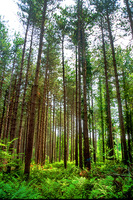 | Back to e-WV
| Back to e-WV
 The West Virginia Encyclopedia
The West Virginia Encyclopedia
 | Back to e-WV
| Back to e-WV
 The West Virginia Encyclopedia
The West Virginia Encyclopedia

West Virginia is the third most forested state behind Maine and New Hampshire. Forests cover approximately four of every five acres in West Virginia, supplying 2.5 percent of America’s total timberland. West Virginia forests are important to the state’s economy and a determining element in its ecology.
West Virginia woodlands are exceptionally diverse, with about 90 species of forest trees. There are at least a dozen other species of small trees, including redbud, dogwood, hawthorn, and sumac, and another dozen or so shrub species, including rhododendron, witch hazel, and others.
Several factors account for this rich diversity. These factors include the wide range in elevation, from 247 feet at Harpers Ferry to 4,861 feet at the top of Spruce Knob; the variation in annual precipitation, from 25 inches or less at Moorefield to nearly 70 inches at Pickens; the large difference in the average frost-free period, from 119 days at Bayard to 193 days at Logan; and the many ridges and coves that face different directions. The state’s far-flung geography is also important. The tip of the Northern Panhandle stretches farther north than Philadelphia; the Eastern Panhandle reaches nearly to Washington; the state’s western tip is 40 miles west of Cleveland; and West Virginia’s southernmost point lies 60 miles farther south than Richmond. As a consequence of these many variations, trees with quite different requirements grow well in different parts of the state.
West Virginia’s primarily hardwood forests can be divided into a western hills section, a high Allegheny Mountains section east of the western hills, and the ridge and valley area east of the Allegheny highlands. The trees in the western hills are similar to those found in the central hardwood forests of the Midwest; those in the high Alleghenies similar to those of the northern forests of New England; and those in the extreme eastern counties similar to those of the coastal states.
The 12 softwood tree species found in the original forest are all still present. Hemlock is probably the most common. Red spruce, once occupying nearly 469,000 acres mostly above 3,200 feet, and white pine, one of six pine species scattered in the state and once growing in nearly pure stands on approximately 300,000 acres, now grow on a greatly reduced acreage. Some, such as eastern larch or tamarack, balsam fir, and red pine reach their southernmost extent in West Virginia, but are not plentiful.
Since every tree in the forest supplies food and shelter for a varied and abundant assemblage of life, the total forest complex is wildlife habitat. The list of organisms present in the West Virginia woods is long, and includes bacteria, algae, fungi, worms and nematodes, insects and spiders, amphibians and reptiles, birds, mammals, ferns, and herbaceous and woody plants, among others.
The U.S. Census published the first statistical compilation on West Virginia forests in 1880. Naturalist A. B. Brooks compiled a report in 1910, and the U.S. Forest Service published reports periodically beginning in 1952. The 1952 report stated that 64 percent of the state was forested. This changed to 74 percent in 1964, 75 percent in 1978, and 78 percent — its current percentage — by 1988. This regrowing of the forests, one of the most important changes in West Virginia in the 20th century, resulted from the abandonment of agricultural lands. It is a remarkable rejuvenation, especially when one considers the thousands of acres irreversibly lost in recent decades to highways, utility rights of way, residential subdivisions, and urban sprawl.
The 2016 report showed that oak/hickory forests comprised 74 percent of the state’s forestland and more than 50 percent of the forestland in all but five counties. Pitch/Virginia pine, the most common softwood, accounted for only two percent overall. The fastest-growing hardwood is yellow-poplar, which has increased from nine to 17 percent of the state’s hardwoods since 1949. However, there are concerns that an increase in yellow-poplar weevils could take a toll in the near future. Since 1975, large-diameter stands have steadily increased, indicating that West Virginia’s forests are maturing. At the same time, medium- and small-diameter trees have steadily decreased. The emerald ash borer is rapidly destroying the state’s ash trees.
As of 2000, only 11 counties had less than two-thirds of their land in forest, including three of the four Northern Panhandle counties: Hancock, Brooke, and Ohio; 26 counties were more than 80 percent forest. Webster County and McDowell County, both at 93 percent, were the most heavily forested; the least forested counties were Berkeley and Jefferson, at 44 percent. Only Maine and New Hampshire had more forest cover than West Virginia. In 1990, the West Virginia forest was described as 64 percent saw-timber, 26 percent pole-timber, and 10 percent still in the seedling stage.
There has been a great expansion in overall volume of timber, from 8.7 billion board feet in 1945 to 17.5 billion in 1952, 29 billion in 1964, 33.6 billion in 1978, and 76 billion in 2021. This is board feet in standing trees, or ‘‘stumpage.’’
Fire remains a threat to West Virginia forests and is especially prevalent in southern counties. Fires kill some trees outright, especially in the spring, and injure others. Decay-causing organisms move into the wounded trees, ruining them for lumber production. The over-browsing of deer is also a problem in our forests, resulting in the destruction of seedlings and damage to mature trees and shrubs.
Written by William H. Gillespie
Brooks, A. B. Forestry and Wood Industries. Morgantown: West Virginia Geological & Economic Survey, 1910.
DiGiovanni, Dawn M. Forest Statistics for West Virginia: 1975 and 1989. Radnor, PA: U.S. Forest Service Northeastern Forest Experiment Station, 1989.
Gillespie, William H. & Earl L. Core. Forest Trees of West Virginia. Charleston: West Virginia Division of Forestry, 1976.